Planting Asparagus need not be dull: when the bees swarm
It seemed like a dull, straight-forward job I handed to my son Timothy yesterday. I was, after all, thinking of him, as is not unusual. He spends lots of time toiling over computers. What better antidote to all that inactivity, than plenty of digging?
Dig a couple of new trenches for the asparagus roots–the entire width of the garden, at least 8″ deep, and about a foot wide. Those were my instructions. And I think Timothy was a bit bored with this job, although at least he had (doubtless) the comfort of knowing that he was getting a good workout, at least. Your men need muscles, you know, and what more satisfying way to build these muscles than to ensure future nutritious meals? Think asparagus frittata, asparagus sauteed with garlic, roasted and drizzled with olive oil, oh, the lovely things you can do with a handful of fresh asparagus!
All these delightful things can be done with store-bought asparagus, too, Gentle Reader, although of course there’s a satisfaction from growing your own that can’t be bought. But you already know that I’m a nut in this area of growing your own food, right?
So anyway, Timothy was toiling away at this rather boring chore. Then the bees swarmed, and the dull part of the morning was over just–like–that.
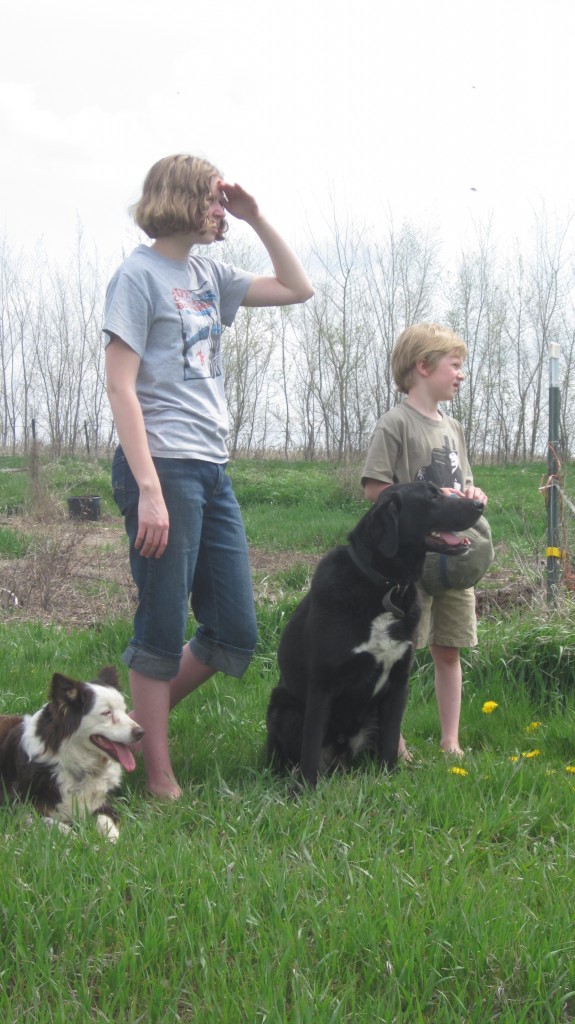
All action stopped as the bee swarming drama unfolded. Here Bea, Amalia, Ollie and Malachi stop to watch, at a safe distance, natch.
Before I tell you the bee-swarming story, though, I want to write a bit about asparagus, which is a lovely, easy-to-grow perennial vegetable grown for its delicious young shoots, as you undoubtedly already know. One of the very first vegetables to poke out of the garden (right behind rhubarb stalks and spring onions here in Nebraska) it is a joyous day indeed, when one can pick enough fresh young shoots for an asparagus frittata.
I have a few asparagus plants in my garden, but only a few, and I’m wanting a large patch that will feed the fam for several weeks every spring.
It must be noted here, however, in an effort to fully disclose the truth (from time to time), that the very first shoots go straight into the gardener’s mouth, raw and sweet and delicious, as, perhaps, they should. These shoots are packed with B vitamins, vitamin C, calcium, and iron, all nutrients desperately needed by your average gardener, and are delicious, to boot. Fresh-picked spears are far more tender and tasty than store-bought ones, but of course you knew that already, didn’t you? And the thing is, though the planting is a bit labor-intensive, not to mention perhaps a little dull, the growing of asparagus is easy-peasy, and once you’ve established a decent asparagus bed, you’ll have it for at least 20 years or more. That’s a lotta asparagus, you know.
So are you ready to plant a few roots? First things, first. Then I’ll get to the bees swarming story, and it’ll be worth the wait, I promise.
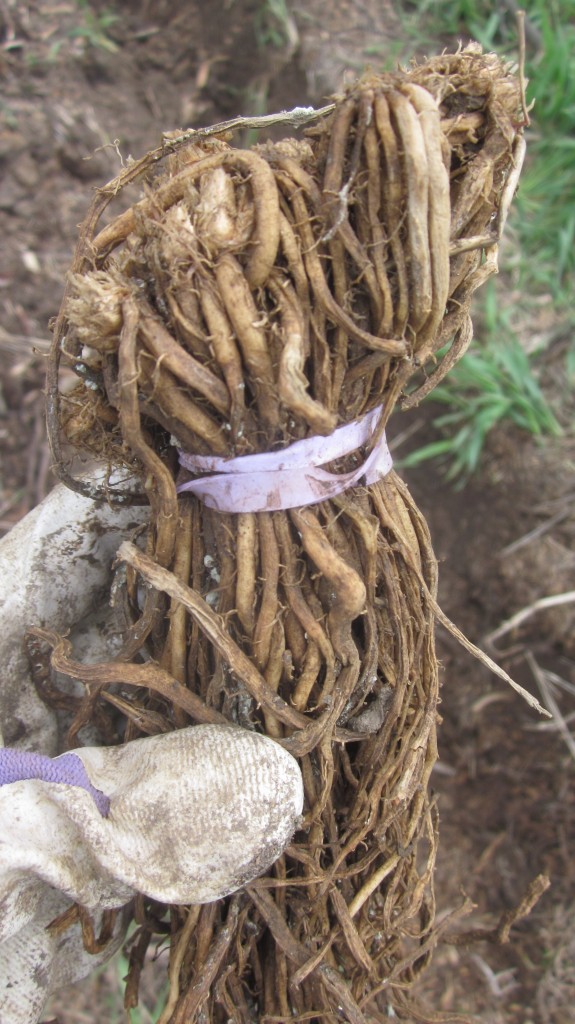
Here’s a bundle of healthy one-year asparagus roots, bound with a lavender rubber band, help with my lavender-gloved hand. Cool, huh?
Here’s how to plant asparagus roots in just a few simple steps:
- Choose your site carefully. An already-cultivated garden spot is ideal and is what I chose for my asparagus bed. If you have a brand new spot full of grass or weeds or whatnot, you will have to destroy all that vegetation first, and it’s actually better to have done that . . . erm. . . . last fall, with a good strong hoe or a tractor with a blade. But if you choose to do it this spring, make sure that you pile plenty of mulch on top of it so all that grass doesn’t just start coming back up and choking out your asparagus roots. That happened to me once. Sadly. But let’s not go there, today. We have a bee story to get to.
- Dig a trench. This is not a chore for the faint-of-heart or slight-of build. I actually asked my strong son Timothy to do this for me, and as he is a good son and enjoys eating asparagus, (not to mention more interesting plans for the rest of the day) he grabbed a shovel and got to it. The trench should be at least 8″ deep and nearly a foot wide.
- Plant your roots. Place healthy one-year roots spider-like in your trench, crowns up, about 18″ apart, with the “legs” splayed nicely about, to ensure plenty of space for growth.
- Sprinkle a layer of manure, or compost, or a combination of the two on top of the roots, and then a couple of inches of crumbly topsoil. Asparagus is a heavy spring feeder and will enjoy a layer of compost or manure in the springtime from now on, too.
- Water well. With a hose. Or a bucket. Or a nicely-timed rainstorm, whatever.
- Repeat layers of topsoil and watering for the next few weeks, until the trench is full. Of soil, not water, though a bit of both wouldn’t hurt a bit.
- Mulch well with wood chips, or straw, or hay, or whatever you can get your hands on.
- Keep the weeds away and water during dry periods. Your baby roots will do better with no competition for nutrients and water, natch!
- Don’t pick for the first two seasons. Jeepers, here’s the hard part, but if you can control your impulse to pick those dainty succulent shoots, your roots will be so much stronger. So take pictures of them, admire them, show them to your family, but don’t pick ’em. Not yet.
- Pick and enjoy spears your third season. It may seem like a long wait, but it’ll be worth it, I promise you! With just a bit of care and prudent harvesting, you’ll have at least twenty years of delicious asparagus harvests to look forward to!
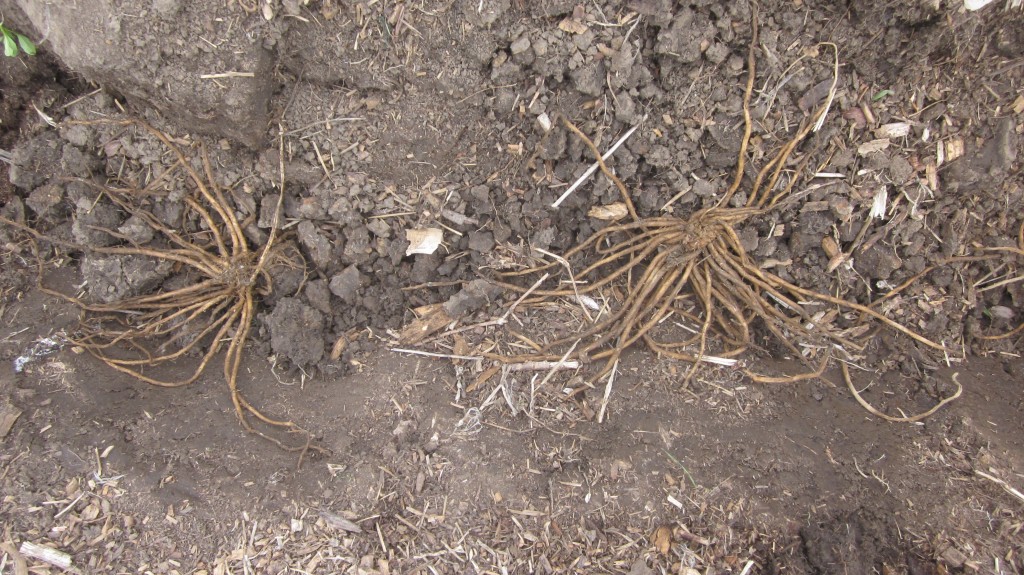
Here you can see the roots positioned properly in their trench. They really do look like spiders, don’t they?
Asparagus thrives in nearly every area that has winter ground freezes or dry seasons. The mild, wet regions of Florida and the Gulf Coast are about the only places where it’s difficult to grow, apparently. So what are you waiting for, Gentle Reader? You should be able to buy asparagus roots from nearly any seed catalog that also sells plants, or at your local garden center. Or from me at our farmer’s market in a few weeks, by the way. As usual, I bought too many roots, so I’ll sell the extra to a few folks at market.
Now here’s what happened with the bees.
Timothy is a dutiful son and I’m very very thankful for him and his strong back and his stoic manner and his muscular arms. I hope he reads this so I can enjoy his blushing. He was digging the asparagus trench as I had asked him to, and I was on my knees planting strawberry plants. Then I heard his voice next to me.
“Dad’s bees are upset,” he said quietly. This turned out to be a wildly understated observation. Our three bee hives (although only one of them is inhabited) are located at the far end of my rather impressive garden space. Timothy was digging the asparagus trenches relatively close to them. They’ve given him problems before, actually chasing him to the house on occasion (so he says, anyway) and causing him to give up on a garden task from time to time. I think, personally, that they probably just like his after-shave or his enigmatical manner, or something. They don’t bother the rest of us.
I actually fancy my hypothesis that there are days when Timothy just wants a few hours off from garden toil, and he knows he’ll get them if he runs wildly to the house, swatting about his face and fending off imaginary bees. Whatever.
I looked up and I saw them. How many bees reside in a typical bee hive? 20,000? Half a million? I don’t know, but nearly all of them appeared to be in the air, doing loop-de-loops and elegant flying formations in the air, and meanwhile making a frightful racket of buzzing. Bzzzz . . . . bzzzzz . . .bzzzzzz. There was a cloud of upset bees hovering in the air not far from the hives.
I’m not the bee expert at our house, but I knew that something was not right with the bees, just the same. Timothy, also, has powers of acute observation in this sense, and he went to the house to alert our bee expert, my good husband Bryan. I was heartily thankful that he was actually home this morning. I watched the swarm of bees move from right in front of their hive, to a Scotch pine tree not far away. Bryan came charging out in his full bee-keeping regalia, and walked to the site of the upset bees. It was a proud moment for all of us.
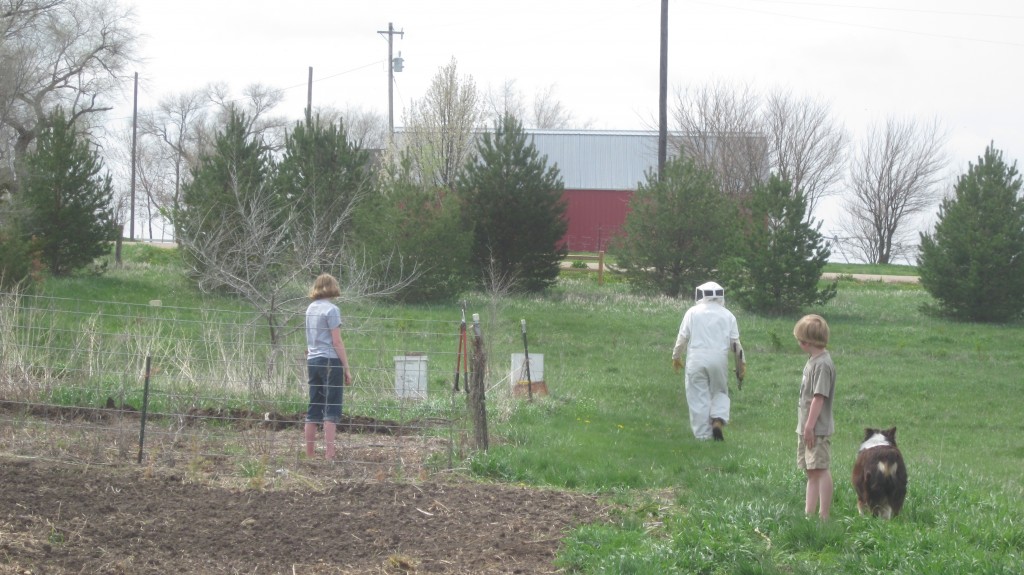
Here all action on the farm stops as Bryan hurries out in his bee-keeping suit. I wish you could see the huge swarm of bees in the air, but I couldn’t get close enough to photograph them.
A large number of bees had, by that time, settled in a large, buzzing clump in a nearby tree, presumably clustering on their queen. Little Mack went flying to the garage for a tree lopper, which Bryan used to prune the tree a bit, lopping off the branches with swarms attached. He then carried the clumps of bees back to the hive, one by one, and put them back where they were supposed to be.
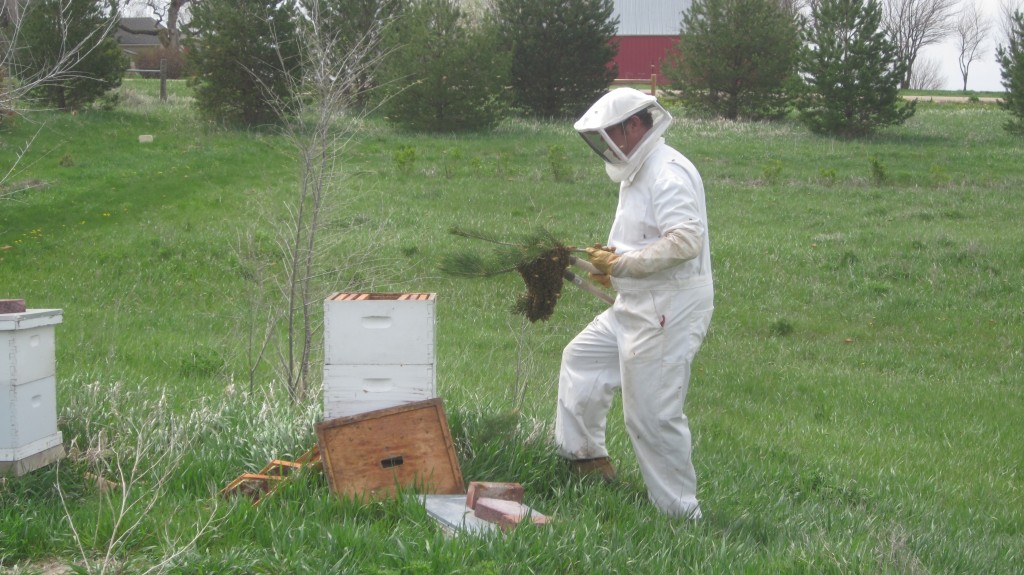
Here Bryan prepares to drop one of several clumps of bees into the hive. He has removed a few frames from the hive to make space.
I was actually hoping that Bryan would put them on his chin for a quick, impromptu bee-beard photo shoot, but no.
I guess that swarming (especially in the spring) is not an unusual thing to occur in an established hive. And, according to old bee-keepers I’ve heard talk about it (i.e. my dad) if a hive of bees is bound and determined to swarm, they’ll do it, no matter what your feelings on the matter are. Bees swarm as a means of reproducing the hive, but often leave behind an unexperienced queen and a weakened hive for the summer.
Today’s bee-keepers tend to actively manage their hives, and there are things that can be done to discourage swarming. In the days of “laissez-faire” beekeeping, the practice of capturing swarms to replenish colonies made early swarms especially valuable.
Here’s an Old English poem I ran across about this:
“A swarm of bees in May is worth a load of hay;
- A swarm of bees in June is worth a silver spoon;
- A swarm of bees in July, let them fly.”
I’m pretty sure I’ve heard my dad quote this little poem, at least once.
After Bryan had settled the bees back into their hive, the excitement over, we settled back into our gardening chores and he went off to work. I noticed later in the day that the bees were clustered on a second, uninhabited hive, so I’m anxious to go out today to see what they’re up to now. I hope they just moved into the splendid digs next door (that empty hive) and we’ll have two hives of bees once more. With all the honey bee problems in the U.S., I am mortally afraid of losing them entirely.
We value the good raw honey that these hard-working little ladies make for us, and the lovely job they do of pollinating all of our plants and flowers, so much, that I’m hoping that they’ve decided not to take off for a more picturesque locale. Like, New Zealand, where (incidentally) they don’t allow the growing of GMO crops and they have healthy honey bees.
So you see that a morning spent digging an asparagus trench need not be as dull as one might imagine it to be . . . perhaps you ought to dig a few roots into your garden space.
You never know what might happen.
- Baker Creek Heirloom Seeds Spring Festival with the girls
- An evening of Swing-Dancing at the Pla-Mor


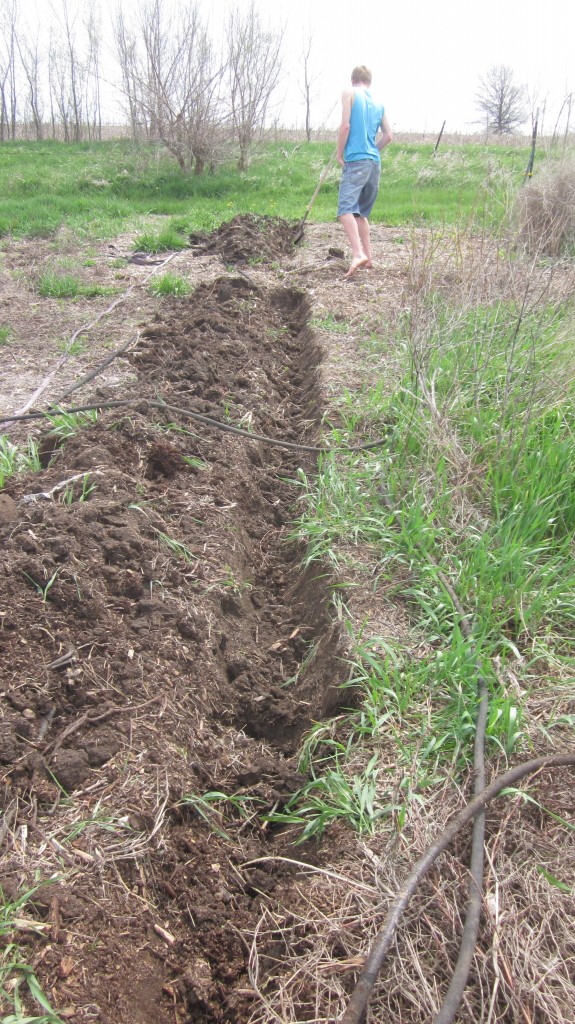
Having met my fair share of bees-a-swarming, my poem is more like,
Run like hell,
Don’t stop for a spell,
Find that hose,
Make believe you’re a rose,
From head to your toes!
Roy, you are so clever to make up that poem on the spot. You made me laugh!
I miss my asparagus……the horriblè grass here would choke it out
Katrina,
Where do you live that your grass is so bad? We’ve got invasive brome and prairie grasses, but plowing the garden up every fall helps keep it in check.
This is so funny. I chuckled out loud at the photo of the children with the caption mentioning that they were impressed by the suited saviour, ready to face the bees. Those children stood immobile, shoulders sagging as if he was going off to his death and they didn’t care either way. You’ll have to give stage directions. Your planting instructions remind me of my own effort at growing asparagus. I never got to taste it. We moved away.
Francene,
My dad always says that you don’t plant fruit trees for yourself–you plant them for somebody else, and I guess that’s the way it was for you and your asparagus! Maybe your husband would dig a few roots into your garden and you could enjoy it in the spring in a couple of years?
So, when my Brian (good lord, our husbands have the same name too???) gets his bees we should give you a shout out? That’s his next plan! Seriously! Wow… My son was just talking to me about asparagus the other day and that I should plant some! Once again, you’ve got me thinking. <3
Good grief, our husbands have the same name? That gave me pause . . . . and you’re getting bees and contemplating planting asparagus??? Dismissed as coincidence, Carrie?? I think not!
wow, that sounds like an adventure indeed, and I loved you wishing for a bee beard photo – did you actually suggest that outloud, or just think it from a safe distance? 😉
GreatGord,
Um, I was . . . er . . . thoughtful enough not to utter my wishes out loud. It was a bit of a tense moment and I didn’t figure my husband would be amused. 🙂
But I was thinking about it pretty hard.
Ha! Thought you might have been 😉
Love your post here!
I was captivated reading this, great pics too, talk about full on! I love growing asparagus, its not only tasty but soo pretty!
Eek about the bees!
I agree, Bek, asparagus spears are just gorgeous!
Hi Amy, I do love your posts and oh yes I love asparagus – bees bit scary though 🙂
The bees look scary, but they probably wouldn’t bother anybody in this swarming state. They are too intent on doing what they need to do! Thanks for your comment, Cher!
You speak so highly of your son Timothy, yet you won’t get him any shoes and he must dig rows 8 inches deep, a foot wide and what looks to be at least 20 feet long, all the time working in bare feet. I do believe in all fairness that you own it to him to let him have the very first raw, sweet and delicious, shoots on spring. Pictures do tell a story, don’t they?
Chef,
I do think you judge me a bit harshly here! 😉 Although my son does work very hard for me, he gets free room and (excellent, ahem) board and lots of other amenities for his trouble. And as for the bare feet . . . I DO buy him shoes, but he is very stubborn to go barefoot as often as possible. Check out any other pictures I’ve posted of him and you’ll see that he’s nearly always barefoot. He even runs barefoot, on our country gravel roads! He is a web designer for his day job, so I daresay doing a little gardening is a good thing before he goes to sit at a computer. He may even agree with you on this point . . . wait . . . don’t ask him. Just take my word for it. 😉
I tried to grow veggies once,and then I realized I had to get my hands dirty in manure based fertilizer. However, I do love fresh grown anything, and frequent the local farmers market!
Farmer’s markets are awesome, Brenda!
We found another place asparagus didn’t grow when we lived in Kansas some 30 years ago. Yes, Kansas. Whatever we did wrong, it just didn’t work out. We didn’t try it again in Arkansas, and we don’t have enough room on our small plot of city land now to try it again. (We didn’t have too much luck keeping bees in Arkansas, either. Guess certain things never worked for us….)
Alana,
This is my second attempt at growing asparagus here in Nebraska, so it does take some care, I guess. At least I found that it won’t do much if the patch is choked with weeds! Keeping bees in the U.S. is becoming harder and harder, as 50% of them now die off every winter.
Cute story Amy….we tried planting a small bed of asparagus one, nothing this arduous or entertaining. Thanks for sharing adding humor to this detailed task 🙂
Liz, this is my second attempt at planting a good-sized asparagus bed. I’m determined to make it work this time!
I love asparagus especially when cheese is melted on top! There is nothing like having raw honey. A beard of bees….Yikes. It would have made an awesome photo! I just thought of a really cool caption for using a photo like that in a blog post. Keep me in mind if you ever get a photo like that:)
I like the way you think, Toni!
Another belter, Fabulous and informative asparagus talk, your wonderful children and a your swarm-busting husband to boot. Just fabulous, sharing now.
You’re a chum, thank you, Anita-Clare!